Entries in Preservation Issues (114)
The El Cortez is a National Historic Place!
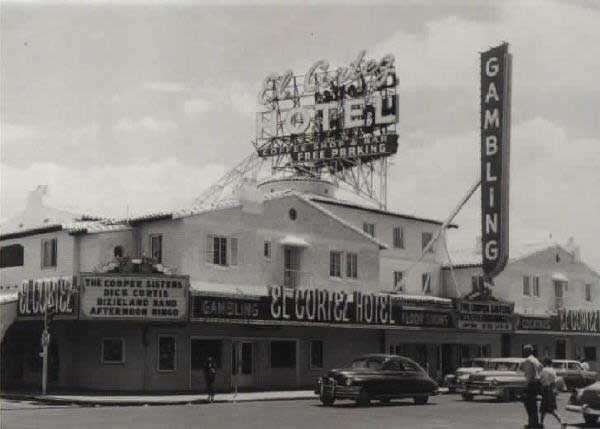
We are thrilled to announce that one of our favorite places, the classic El Cortez Hotel and Casino, on Fremont Street has been added to the National Register of Historic Places!!!!!
If you know us, you know we love the El Cortez and we love the fact it has kept its original facade all these years! Designed by Wayne McAllister, once owned by Bugsy Siegel and pals and owned in its prime by Las Vegas legend, Jackie Gaughan, the El Cortez has sat on the corner of Fremont Street and 6th Street for over seventy years. At one time, our Sears and Roebuck was located across the street. Bet you never bought your back to school clothes at a store across the street from a casino but those of us who grew up in Las Vegas back in the day, WE DID!!!!
When Jackie Gaughan sold the Cortez a few years ago, everyone held their breath. What would happen? Would he sell to developers who would raze the hotel? Would he sell to someone who didn't understand its history or appreciate its neon? Crisis was averted because Jackie kept the casino (and surrounding properties) in the family.
Mike Nolan and his team went to work on restoring the interior of the El Cortez which by then, was known more for its smoky interior and its geriatric clientele.
Today, you can walk through the El Cortez and not feel like your lungs are on fire. Today, the El Cortez appeals to all ages, hipsters, locals and everyone looking for a bargain in a city better known for high priced table service than bargains.
The El Cortez and those who run the hotel have been on the forefront of anchoring the East Fremont Entertainment District and doing all they can to encourage locals and visitors to look beyond the neon canopy of upper Fremont Street and join the fun.
In a city known more for demolitioning it's historic buildings in a party atmosphere, the El Cortez stands as a reminder that classic Las Vegas is worth preserving!
Congratulations to the El Cortez for joining the National Register and all those involved in making this happen!!!!
El Cortez Hotel and Casino, located at 600 Fremont Street in Las
Vegas, was listed in the National Register of Historic Places (NRHP) on February 13, 2013.
The National Register is the nation’s official list of cultural resources worthy of preservation.
When it opened in 1941, Fremont Street’s El Cortez became the premiere hotel/casino in
downtown Las Vegas. The popularity of El Cortez helped bolster the city’s economic
development while its various owners helped define the city as it emerged as an international
entertainment capital. Following the 1959 installation of the “Welcome to Fabulous Las
Vegas" sign (NRHP listed 2009), new resorts established the Las Vegas Strip and later
eclipsed the popularity of downtown. El Cortez, however, would remain a constant presence
in downtown Las Vegas.
Constructed in 1941, El Cortez is primarily Spanish Colonial Revival style but reflects the
1952 remodel when the façade was ‘modernized’ and the marquee and prominent rooftop
signage were added. El Cortez remains one of the oldest establishments on Fremont Street
and is the only establishment to continue operation under its original name. Today, El Cortez
Hotel and Casino continues to convey the feeling of 1952 Las Vegas.
“We are pleased that such a beloved and well-tended icon has been given this national
recognition. We encourage visitors looking for an authentic vintage Las Vegas vacation to
seek out this cherished resource,” said Rebecca Palmer, acting state historic preservation
officer.

History of the El Cortez: http://classiclasvegas.squarespace.com/downtown-history/2007/5/3/a-brief-history-of-fremont-street-cont-1.html
Other stories:
Neon Museum Officially Opening Oct. 27th
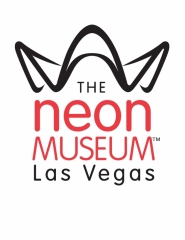
THE NEON MUSEUM TO OFFICIALLY OPEN TO THE PUBLIC ON SATURDAY, OCT. 27
Featured Attractions Include Guided Tours of Neon Boneyard,
New Visitors’ Center Inside Historic La Concha Motel Lobby
After more than 15 years of planning, the Neon Museum, a Las Vegas historical institution dedicated to the preservation and celebration of some of the city’s most distinctive architectural landmarks, will officially open its doors to the public on Saturday, Oct. 27.
The Neon Museum, home to a collection of more than 150 neon signs dating from the 1930s, is the largest collection of neon signage in the world and a unique record of Las Vegas’ colorful history. Inside a two-acre outdoor museum space known as the Neon Boneyard, iconic signs from the city’s most celebrated properties — including the Moulin Rouge, the Desert Inn, the Flamingo and the Stardust — are displayed alongside those from various other bygone restaurants, hotels and businesses.
The museum’s new visitors’ center will be located on-site in the recently rehabilitated La Concha Motel lobby, the seashell-shaped, Mid-Century Modern architectural masterpiece designed and built by architect Paul Revere Williams. Originally constructed in 1961 on Las Vegas Boulevard South, next to the Riviera Hotel’s current location, the La Concha lobby was saved from demolition in 2005 and moved to its current location in downtown Las Vegas in 2006.
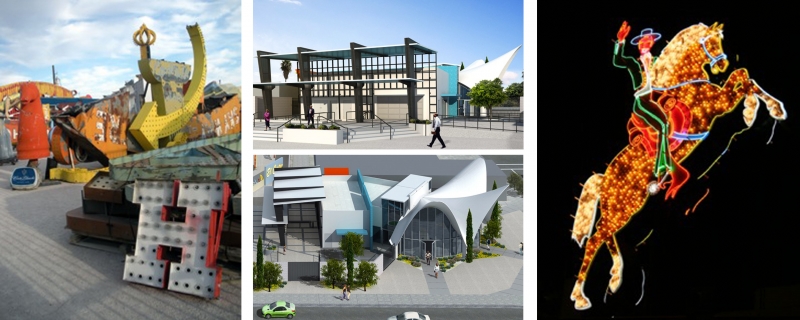
According to Bill Marion, chair, Neon Museum’s Board of Trustees, the museum’s official opening will bring both a significant cultural and economic impact to the community. “There is renewed interest in ‘old’ Las Vegas and in the rediscovery of the historical downtown area. The Neon Museum will play a major role in this renaissance by bringing new visitors to downtown Las Vegas, by creating additional opportunities for tourism growth and by adding to the ongoing economic revitalization of the area,” says Marion.
Tours of the Neon Boneyard, which last approximately 45 minutes, will be available to the public every half hour starting at 10 a.m., with the last tour departing at 4 p.m., every Monday through Saturday. Tickets are $18 for adults; $12 for students with valid ID, senior citizens, veterans and Nevada residents. Children ages 6 and under are free. Tour capacity is limited. To ensure admission on the date and time desired, visitors are advised to purchase their tickets in advance through the Neon Museum’s Web site, www.NeonMuseum.org. The La Concha Visitors Center will be open Monday through Saturday from 9:30 a.m. until 5:30 p.m. Both facilities are located at 770 Las Vegas Blvd. North, Las Vegas, NV, 89101.
“Visitors from around the world have been eagerly anticipating the Neon Museum’s opening for many years, so it gives us tremendous pleasure to be able to unveil this remarkable and historic collection to the public,” says Danielle Kelly, executive director, Neon Museum. “Our goal is to give guests an enhanced appreciation for Las Vegas’ rich visual culture while celebrating the beauty and craftsmanship of a distinctly modern art form.”
In addition to the Neon Boneyard and visitors’ center, the Neon Museum has partnered with the City of Las Vegas to create the Las Vegas Signs Project, in which restored signs from the museum’s collection have been installed on Las Vegas Boulevard between Sahara and Washington Avenues — a stretch of roadway that has been designated a National Scenic Byway by the U.S. Department of Transportation. Currently, seven restored signs from the 1950s are on display, including the Silver Slipper, the Bow & Arrow Motel, Binion’s Horseshoe, Society Cleaners, the Lucky Cuss Hotel, the Normandy Hotel and the Hacienda Horse and Rider.
The museum’s collection also includes nine restored signs installed as public art throughout the downtown area. The Downtown Gallery begins on Fremont Street at Las Vegas Blvd. and extends west toward Third Street. Signs in this gallery include Aladdin’s Lamp, The Flame Restaurant, the Chief Court Motel, Andy Anderson, The Red Barn, Wedding Information, the Nevada Motel and Dots Flowers. Further south, the 5th Street Liquor sign, located on Casino Center St. near Garces Ave., features a classic example of the type of animation that was frequently used in neon signage, and the Landmark Hotel sign, located on Paradise Road near Convention Center Dr., has been placed near the site where the iconic property stood until its demolition in 1995.
ABOUT THE NEON MUSEUM
Founded in 1996, the Neon Museum is a non-profit 501(c)3 organization dedicated to collecting, preserving, studying and exhibiting iconic Las Vegas signs for educational, historic and cultural enrichment. In addition to a two-acre outdoor exhibition space known as the Neon Boneyard, the museum also encompasses a visitors’ center housed inside the former La Concha Motel lobby as well as 16 restored signs installed as public art throughout downtown Las Vegas. Public education, outreach, research, archival preservation and a grant-funded neon sign survey represent a selection of the museum’s ongoing projects. Both the Neon Boneyard and the La Concha Visitors’ Center are located at 770 Las Vegas Blvd. North in Las Vegas. For more information, visit www.NeonMuseum.org or follow us on Facebook or Twitter.
El Cortez is going for Historic Designation
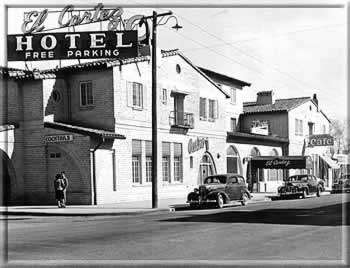
The owners of the venerable El Cortez are working towards getting the venerable downtown casino on the National Register of Historic Places.
It's brick facade dates back to 1941 when Marion Hicks built the small casino with 59 rooms. When Bugsy Siegel finally made that long drive up the highway in the early 1940s, it was not to have a fever dream about building a carpet joint on the Strip but to muscle his way into the race wire at the El Cortez. But the Hollywood story sounds betterm no doubt. Siegel finally got his hands on the El Cortez when Hicks sold the property to him in 1946. Renowned Southern California architect, Wayne McAllister did the remodel on the El Cortez in 1946.
Local hotel entrepreneur J. Kell Houssels, Jr, bought the property and under his stewardship it thrived.
In 1963, young Jackie Gaughan, who had come to Las Vegas in 1943 when he was stationed at the old Air Base (that would become Nellis). He moved his wife Roberta and two sons, Michael and Jackie, jr to Las Vegas in 1951. He bought a small 3% of the Boulder Club and 3% of the Flamingo with partner Eddie Barrick. Jackie had a knack for sports books and handicapping. In 1961, he and partner Mel Exber bought the Las Vegas Club and in 1963, they bought the El Cortez. Gaughan hired Wayne McAllister to oversee the design and construction of a new room tower.
Jackie invented the Fun Book, filled with coupons for free drinks, free slot pulls and two for one dinners. Like Benny Binion, he had a knack for understanding and treating his customers like kings.
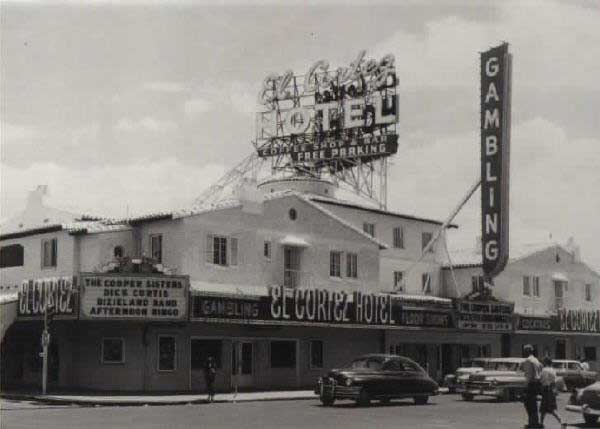
Today, the El Cortez has been restored and is thriving. It is a major partner in the East Fremont Entertainment District.
The application is being put together by historian Pete Moruzzi. It still needs the approval of the State offiice of Historic Preservation and the National Park Service. Unlike many of the casinos on the Strip where anything considered old must be upgraded, paved over or blown up, the El Cortez (and the Golden Gate) have relished their roots and still have their historic bones intact.
It's Spanish Colonial Revival architecture and its role in the post-war development of Las Vegas should not be overlooked.
Dr. Michael Green, historian and teacher at the College of Southern Nevada, says, "I think the El Cortez belongs on the historical registry. It's one of the oldest hotel-casinos in one of the world's leading resort cities. It reflects the architecture of its time. It symbolizes the evolution of Las Vegas through its own history of growth and controversy."
"Its owners have included some figures of considerable historical significance. One of its builders, Marion Hicks, appears to have had some ties to Meyer Lansky, and Moe Sedway and Bugsy Siegel, the owners who came after Hicks, definitely were part of organized crime. Their successors include two of the most important figures in the history of Las Vegas."
"J. Kell Houssels, Sr., owned several casinos downtown and eventually, with the Tropicana, on the Strip, but also was active in other businesses such as transportation and restaurants, and involved in real estate and community development. Jackie Gaughan bought the El Cortez from him with his partners, and Gaughan has been a pioneer in locals casinos and their promotion. The El Cortez contains a lot of Las Vegas history."
When I was growing up in Las Vegas, Fremont Street was the heart and soul of the city. We did our shopping, our dining, our cruising on weekend nights ala American Graffitti , all on Fremont Street. Across the street from the El Cortez was our Sears store with its pylon neon sign. Our moms had no problem taking us to Sears and never blinked twice at the gambling casino across the street.
The roof top sign was added in 1952. The other roof top signs for the El Portal Theater and the five and dime store, Coronet have long vanished from the downtown skyline but the El Cortez management keeps and maintains their sign. It's glowing neon can be seen up and down Fremont Street.
Pete Moruzzi has unearthed a deed for the property that goes back to the mid-1940s. Listed as owners are Moe Sedway, Gus Greenbaum and other mob associates of Benjamin "Bugsy" Siegel. Though Siegel would soon begin to focus on building the Flamingo Hotel out on the Strip, the El Cortez continued to be a major player on Fremont Street. It still is today and we hope for years to come.
We completely support historic designation for the El Cortez.
The Mob Museum is coming soon!

National Museum of Organized Crime and Law Enforcement opens in Las Vegas on February 14, 2012
There are two sides to every story — and then there’s the truth. Uncover the real life battle between organized crime and law enforcement when The Mob Museum opens to the public on Valentine’s Day, February 14, 2012. The Mob Museum, the National Museum of Organized Crime and Law Enforcement, is a world-class destination in downtown Las Vegas. It presents an exciting and authentic view of the mob’s impact on Las Vegas history and its unique imprint on the world.
The Museum, which has already acquired one of the most iconic artifacts in mob history – the brick wall from the St. Valentine’s Day Massacre, will open on the 83rd anniversary of the infamous Massacre, considered one of the most significant days in Mob history. Admission is $18 plus tax for adults ages 18-plus; $12 plus tax for children ages 5 to 17 and students ages 18 to 23 with ID; $14 plus tax for seniors, military, law enforcement and teachers; and $10 plus tax for Nevada residents of all ages. Museum hours will be Sundays through Thursdays from 10 a.m. to 7 p.m.; and Fridays and Saturdays 10 a.m. until 8 p.m.
With tales so intriguing they need no embellishment, The Mob Museum reveals an insider’s look at the events and people on both sides of this continuing battle between organized crime and law enforcement. True stories of mob history are brought to life in a bold and contemporary style via engaging exhibits and multi-sensory experiences. The Mob Museum puts the visitor in the middle of the action through high-tech theater presentations, iconic one-of-a-kind artifacts and interactive, themed environments.
The Museum’s board of directors is headed by Ellen Knowlton, former FBI Special Agent in Charge, Las Vegas Division, and a 24-year FBI veteran. The Mob Museum boasts a highly respected board including professionals from local and state government, law enforcement, the judicial system, media and the business community. A key visionary for the project and current board member is former Las Vegas Mayor Oscar B. Goodman, a previous go-to defense attorney who made a name for himself representing such reputed mobsters as Meyer Lansky, Frank “Lefty” Rosenthal and Anthony Spilotro, among others.
Artifacts to be integrated throughout the Museum’s interactive exhibits provide an insider’s look into many of organized crime’s biggest names, including, Alphonse Capone, Dion O’Bannion, George Moran, Charlie “Lucky” Luciano, Meyer Lansky, Ben Siegel, Sam Giancana, Joe Bonanno, Frank Rosenthal, Mickey Cohen, Tony Cornero and Tony Spilotro to name just a few. The Museum is located in what many consider the ultimate artifact, the former federal courthouse and United States Post Office. Completed in 1933 and listed on the Nevada and National Registers of Historic Places, it housed the very courtroom where, in 1950, one of 14 national Kefauver hearings was held to expose and control organized crime in America. Meticulously rehabilitated for The Mob Museum, the building is significant not only for its neo-classical architecture reminiscent of the period in which it was built, but also for the historic events that unfolded inside of it.

The Museum is also working with the FBI and many famous undercover agents who made a career of fighting the Mob, including legendary agents Joe Pistone who infiltrated the Mob posing as a small time jewel thief, Donnie Brasco; and Cuban-born Jack Garcia who successfully ingrained himself into the Gambino family.
In addition, many items relating to historic eras and specific industries, such as prohibition, money laundering and gaming, will help to tell the story of the mob’s influence on these areas. Items and artifacts relating to law enforcement’s role in helping to eradicate and control the Mob, such as weapons, wiretapping tools and tactics and crime scene photos, will also be part of The Museum experience.
Three major exhibits in The Museum include Mob Mayhem, The Skim and Bringing Down the Mob. Mob Mayhem furthers the understanding of violence as a way of life within the world of organized crime. This exhibit is the setting for the Museum’s iconic artifact—the wall from Chicago’s St. Valentine’s Day Massacre – and sets the stage for law enforcement strategies that will combat it.
The Skim, yet another exhibit within The Museum, dissects the illegal skimming of profits off the top of a casino’s earnings, which was commonplace in Las Vegas for decades and supplied money to the hidden ownership of some casinos – ownership that was most often hidden from regulators.
Bringing Down the Mob is a highly interactive exhibit that focuses on wiretapping – one of the most important tools used to effectively investigate and prosecute organized crime cases beginning in the late 1960s. Visitors will learn about the technology, listen in on the mob, learn to interpret coded conversations, examine photos and surveillance footage, take part in a weapons training exercise and learn about living a new life in witness protections programs.
http://cdn.video.lasvegassun.com/media/video/2008/04/20080515_history5_720p.mp4
Mid-Century Modern Weekend is HERE

It's HERE!!! Be sure to get your tickets, it sounds like a wonderful way to connect with Las Vegas' post-war history and its architecture!!!!!
We are thrilled that the ADAS (Architectural and Decorative Arts Society) has carried on the Mid Century Modern celebration that we started a few years ago.
If you love the Mid-Century Modern lifestyle, history, architecture, own a mid-mod home or want to take a tour of mid-mod homes in Las Vegas, this is the event for you.
Tickets to the Las Vegas Mid-Century Modern Weekend are on sale now.
POP, BOOM LIFESTYLE REVOLUTION
ADAS Mid-Century Modern Weekend
Wednesday, October 19 – Sunday, October 23, 2011
ADAS (Architecture and Decorative Arts Society) celebrates all
things mid-century modern with an extraordinary five day event.
A pass for all five days is a very reasonable $100; $90 for ADAS
members. Included is the kick off mixer, general admission to
the Atomic Testing Museum, mid-century vendors; mid-century
architectural seminar; mid-century dinner; fashion show; silent
auction; three mid-century discussion panels; Morelli House
reception; four-hour mid-century neighborhood bus tour. Visit
ADAS website at www.adas-lv.com to purchase your tickets. Space
is limited on most events.
Wednesday, October 19
ADAS kicks off the mid-modern experience by hosting a mixer at the
Atomic Testing Museum, 5:30 – 7:30. Guests will have a lot to entertain
themselves for the evening. A ticket for admission to the museum will
be included in the price of the mixer.
Guests can take the tour that
evening, or can return at a later date.
The Museum store will also bem open for shopping. There will be food and wine in the main reception
area, along with vendors previewing products that were popular in the '50s and '60s.
Event price: $30.00
Thursday, October 20
Again at the Atomic Testing Museum, ADAS is hosting a seminar primarily for homeowners on the evolution and care of these historic buildings. Speakers with hands on experience in this genre of distinctive houses will share their knowledge. Food and wine will be provided.
Vendors who specialize in mid-modern architecture will also be on hand.
Time: 6:00 – 8:00 pm.
Event Price: $30.00
Friday, October 21
A mid-century dinner will be held at Holsum Lofts, catered by Lola’s
Restaurant. In addition to enjoying foods of the time period, diners will
enjoy mid-century fashions in a multi-generational fashion show. There
will also be a silent auction to tease the senses. Time: 6:00 – 9:00 pm
Event Price: $50.00

Saturday, October 22
The El Cortez Hotel will be the venue for this free event co-sponsored
by the City of Las Vegas. There will be food and drink, followed
by three expert panels. After the panel presentation there will be a
reception at the Morelli House.
1:00 pm “Mid-Century Life Style Evolution” Local author and
architect, Robert Fielden (Creating Place: Remaking America Green )
leads a discussion with author and architectural historian, Peter Moruzzi
and others on the profound impact of midcentury design and architecture
on American life in the middle of the 20th century.
2:00 pm “Family Feud: Havana vs. Las Vegas in the 1950s” Peter Moruzzi, presents an illustrated presentation from his book, Havana Before Castro-When Cuba Was a Tropical Playground.
Before Castro’s revolution, Havana and Las Vegas were rivals for the title of the “Monte Carlo of the Americas.” Cuba’s exotic tropical setting, wild reputation, close proximity, and supportive government inspired the mob to invest heavily in fabulous hotel-casinos such as the Capri, Riviera, and Nacional. Yet, many of these same investors were also among Vegas’ biggest boosters - Moe Dalitz, Sam Tucker, and front man Wilbur Clark. In 1958, the Nevada Gaming Control Board forced them to choose, Havana or Las Vegas, but not both.
3:00 pm “Dolls, Dons, and Dictators,” Architectural historian, Peter Moruzzi (Havana Before Castro – When Cuba Was a Tropical Playground); author Wendy Mazaros (Vegas Rag Doll); Myer Lansky II; and local author and historian Michael Green engage in a spirited and expanded discussion about the parallel worlds of Las Vegas and Cuba, drawing from their insights and some of their own personal real life
experiences.

4:00 pm - 6 pm “Cha, Cha, Cha” Cuban inspired reception with music,
drink and refreshment at the Morelli House, 861 E. Bridger.
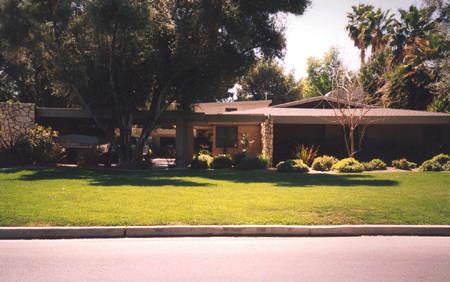
Sunday, October 23
Mid-Mod Bus Tour
Hosted by well known realtor and mid-century modern real estate expert
Jack LeVine, guests will take a four-hour tour on an open double-decker
bus through iconic mid-century Las Vegas neighborhoods.
In addition to touring neighborhoods, the bus will make several stops to peek inside
select properties. Bus will depart and return to parking lot at Boulevard
Mall. Time: 12 noon – 4 pm.
Event Price: $30.00
Should be a lot of fun as well as informative. So if you love mid-century modern, get your tickets NOW!!!


